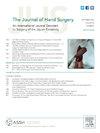肩部开放手术和关节镜手术后的远端单神经病变与神经松解:匹配队列分析
IF 2.1
2区 医学
Q2 ORTHOPEDICS
引用次数: 0
摘要
目的:本研究旨在确定曾接受过肩关节开放手术或关节镜手术并发生远端单神经病(DMN)的患者在接受神经松解术后与未接受过肩关节手术的患者相比是否能获得相同的临床疗效:根据肩关节置换术、肩关节稳定术和肩袖修复术的当前程序术语代码,以及患者是否在肩关节手术后两年内进行过神经松解术(肘管或腕管)来确定患者。另一个队列中的患者因DMN接受了神经松解手术,但之前没有肩部手术史,该队列随后按3:1(对照组与病例组)的比例与第一个队列进行配对。年龄在 18 岁以上的患者也被纳入其中。使用 REDCap 进行病历审查和调查,以收集人口统计数据、手术史、肌电图/神经传导速度结果、术后症状以及患者报告的至少 2 年随访结果:本分析共纳入了 120 名患者(28 例病例,92 例对照)。两组患者中最常见的 DMN 神经松解术是开放性腕管松解术。神经松解术后,病例组术后持续麻木/刺痛的情况多于对照组。在术后疼痛、乏力或患者报告结果方面,两组的情况相似。与对照组相比,病例组术后神经松解后前臂麻木的可能性更大:结论:与未接受过肩关节手术的患者相比,在出现DMN之前接受过关节镜下肩袖修复术和反向全肩关节置换术的患者更有可能在神经松解术后出现持续性麻木或刺痛,并在前臂出现症状:症状发生率回顾性研究 III.本文章由计算机程序翻译,如有差异,请以英文原文为准。
Distal Mononeuropathy and Nerve Release After Open and Arthroscopic Shoulder Surgery: A Matched Cohort Analysis
Purpose
The purpose of this study was to determine if patients who have undergone prior open or arthroscopic shoulder surgery and develop distal mononeuropathy (DMN) achieve the same clinical benefit after nerve release compared with those who did not have a prior shoulder procedure.
Methods
Patients were identified by Current Procedural Terminology code for shoulder arthroplasty, shoulder stabilization, and rotator cuff repair and if they had an ensuing nerve release (cubital or carpal tunnel) within 2 years of shoulder surgery. Another cohort that underwent nerve release surgery for DMN with no prior history of shoulder surgery was identified and subsequently matched to the first cohort by a 3:1 (control:case) ratio. Patients were included if they were over the age of 18 years. Chart reviews and surveys stored using REDCap were used to collect demographics, surgical history, EMG/nerve conduction velocity results, postoperative symptoms, and patient-reported outcomes with a minimum 2-year follow-up.
Results
In total, 120 patients were included in this analysis (28 cases, 92 controls). The most common nerve release for DMN across both cohorts was open carpal tunnel release. Following nerve release, the case group had more postoperative persistent numbness/tingling than the control group. Both groups were similar with regard to postoperative pain, weakness, or patient-reported outcome measures. Residual postoperative numbness following nerve release was more likely to occur in the forearm for the case group than the control group.
Conclusions
Patients with a history of arthroscopic rotator cuff repair and reverse total shoulder replacement shoulder surgery before the presentation of DMN are more likely to experience persistent numbness or tingling after nerve release surgery as well as experience symptoms in the forearm than those without prior shoulder surgery.
Type of study/level of evidence
Symptom prevalence retrospective study III.
求助全文
通过发布文献求助,成功后即可免费获取论文全文。
去求助
来源期刊
CiteScore
3.20
自引率
10.50%
发文量
402
审稿时长
12 weeks
期刊介绍:
The Journal of Hand Surgery publishes original, peer-reviewed articles related to the pathophysiology, diagnosis, and treatment of diseases and conditions of the upper extremity; these include both clinical and basic science studies, along with case reports. Special features include Review Articles (including Current Concepts and The Hand Surgery Landscape), Reviews of Books and Media, and Letters to the Editor.

 求助内容:
求助内容: 应助结果提醒方式:
应助结果提醒方式:


